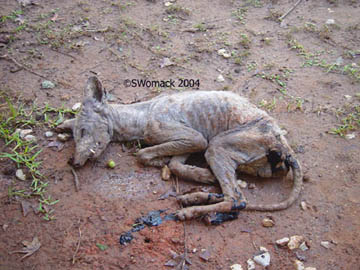
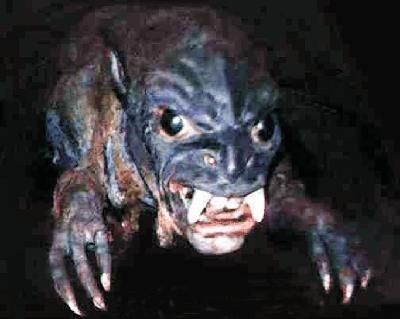
Chupacabra found:
Is it the real deal...or a racoon?
IN THE ODDITIES ARCHIVES
Message in a Bottle
Stolen Brains
Mysterious Dimes
Bird Mummies
History of Halloween
Richard III
Arm Bones
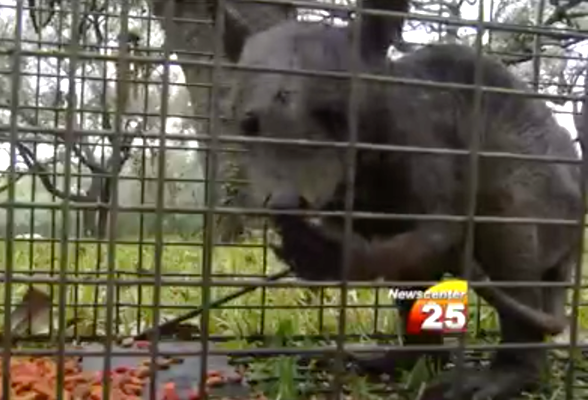
REAL CHUPACABRA FOUND IN TEXAS...OR IS IT REAL?
See the video of this new chupacabra (pictured above) HERE
Yahoo News, April 7, 2014--A Ratcliffe, Texas couple caged what they believed to be a legendary chupacabra. Jackie Stock told KAVU Newscenter 25 that her husband caught the mysterious creature alive on Sunday. "He saw this strange animal sitting up here eating corn," said Stock. “He called me to come and look, and I said, ‘Bubba that looks like a baby chupacabra.’”
The animal had a hairless back, large teeth, and an unusual growl. Some commenters speculated that the creature’s behavior of holding food with its front paws proved it was most likely a hairless raccoon or porcupine. They pointed to a November 2011 Vero News report about Florida’s Vero Beach Animal Control, which caught and identified another mysterious animal as a hairless raccoon. The South Texas creature appeared to have physical characteristics similar to the Florida hairless raccoon.
But Arlen Parma, a fellow Ratcliffe resident, refuted the notion that the Stocks’ animal was a raccoon saying, “You know I hunted coons you know, 20 years with dogs and all that and I ain’t never seen nothing that looks like that right there.” Parma added that the beast had a distinctive growl. “Coon don’t make that noise, or a possum. What makes that noise? I guess the chupacabra does. I don’t know,” Parma told the station.
See the article HERE
Here is the chupacabra found in 2011 that has been identified as a raccoon with mange

Other chupacabras previously found...were they coyotes with mange?
Coyote with fur
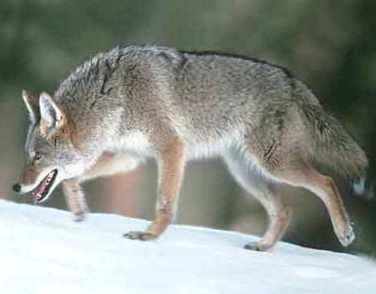
Coyote with mange
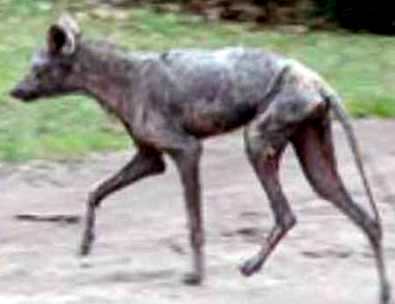
University of Michigan
October 2010
The chupacabra—the legendary hairless animal popular among cryptozoologists—may be caused by parasites, according to researchers at the University of Michigan last week.
The chupacabra, literally meaning “goat sucker” in Spanish, has terrified livestock owners for years, with reports first appearing in Puerto Rico. Soon after, more reports emerged in Mexico and in the Southwest portions of the US of a fanged, hairless, monster that sucks blood.
Researchers say that the real cause behind the chupacabra is a tiny parasite called Sarcoptes scabiei, which causes scabies in coyotes as well as humans. Coyotes with severe scabies infections are now thought to be the source of the chubacabra sightings.
The scabies burrow under the skin of the coyotes and cause “extreme cases of mange” in the animals, the report noted.
"Whenever you have a new host-parasite association, it's pretty nasty," said University of Michigan biologist Barry OConnor in a statement.
"It does a lot of damage, and mortality can be relatively high because that host species has not had any evolutionary history with the parasite, so it has not been able to evolve any defenses like we have." Large numbers of the mites lead to severe infections and damage to the coyote’s skin tissue, causing inflammation, open sores, and excessive hair loss.
“Put it all together, and you've got an ugly, naked, leathery, smelly monstrosity: the chupacabras,"
the report stated.
However, the mite infections do “not exactly” cause the animals to kill and suck blood, the report said.
"Because these animals are greatly weakened, they're going to have a hard time hunting” and so they prey on smaller livestock like sheep and goats, OConnor added. "So they may be forced into attacking livestock because it's easier than running down a rabbit or a deer."
See the article HERE.
